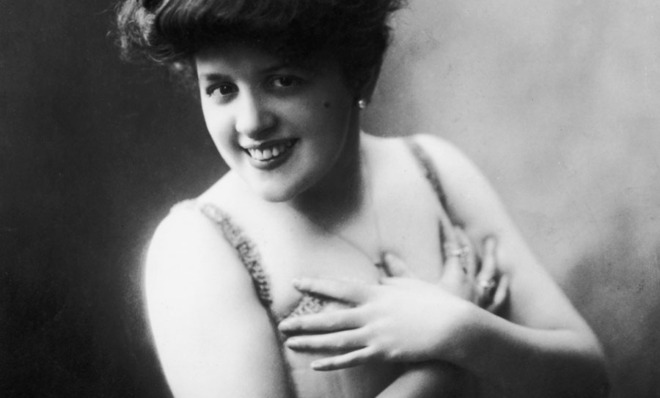How to grow your bosom (according to 100-year-old beauty books)
Sweet food + sweet thoughts = sweet bosom


In the 19th and early 20th centuries, even the most fevered dreams of vanity couldn't have imagined the precarious magic of surgical breast augmentation. To think that there would come a day when women could have a doctor stuff bigger, firmer breasts into the space nature had designated parking for compacts only. Yet many women of a century past were just as obsessed with beauty as those who go under the knife today, and just as desperate for an ample bosom.
The Anonymous Countess C__, authoress of 1901's Beauty's Aids feels your pain, Tiny Breasted Woman:
Many women are troubled by the scantiness of their figure. How can they go to balls when they are afraid to wear low dresses. They are obliged to hide the defect under waves of muslin and lace, and the dancers' mocking glances soon show that they are not deceived by the artifice. What then be done to remedy this inconvenience, and to gain this envied and enviable beauty of form?
Yes, they're laughing at you, dear. With your ruffled and padded bodice, trying to pretend you're shaped like a real woman and not the sexless corkboard you actually are. Don't fear, my little pancake. There are options.
The Week
Escape your echo chamber. Get the facts behind the news, plus analysis from multiple perspectives.

Sign up for The Week's Free Newsletters
From our morning news briefing to a weekly Good News Newsletter, get the best of The Week delivered directly to your inbox.
From our morning news briefing to a weekly Good News Newsletter, get the best of The Week delivered directly to your inbox.
1. Handle with care
If literature of the era is to be believed, corsets were as much hated as they were ubiquitous. Though a necessary evil to keep a woman supported and presentable, nearly every beauty advice writer has something terrible to say about them. Not only did they compress your lungs and weaken your abdomen, they suffocated your breasts and stopped them from growing. In fact, any undue pressure put upon the bosom might result in its deflation. Or cancer. Says Lola Montez in 1858s The Arts of Beauty; Or, Secrets of a Lady's Toilet:
Above all things, to avoid, especially when young, the constant pressure of such hard substances as whalebone and steel; for, besides the destruction to beauty, they are liable to produce all the terrible consequences of abscesses and cancers. A young lady should be instructed that she is not to allow even her own hand to press it too roughly.
Although Montez did not want ladies to handle their breasts too roughly, she did want them to be handled, and often. She provides a recipe for a growth serum:
Tincture of myrrh 1oz.
A free daily email with the biggest news stories of the day – and the best features from TheWeek.com
Pimpernel water 4 oz.
Elder-flower water 4 oz.
Musk 1 gr.
Rectified spirits of wine 6 oz.
This mixture was to be "very softly rubbed upon the bosom for five or ten minutes, two or three times a day."
Most of the other topical treatments suggested for growing a plump bosom are simpler. Florence Courtenay, in 1922's Physical Beauty: How to Develop and Preserve It, assures her readers that while their flat busts are an offense against nature, they can be repaired:
If you are flat-busted, do not despair. A flat, undeveloped condition of the bust — it is not a natural one — may be remedied without great difficulty. The best way to do so is by massage. To develop atrophied bust or neck muscles in connection with massage, pure olive oil or coconut butter is still the best food known. Rubbed in with a rotary motion with an upward pressure and a firm upward stroke, together with the application of hot and cold water alternately before massaging, oil or butter will produce results.
The old butter-boob treatment. Works every time.
2. Where to find the best and worst breasts
The anonymous Countess C___ believed that geography has a lot to do with the comeliness of a bosom. She recommends not being German or English:
Women are not dowered with these natural advantages to the same degree in all countries. As a rule the English are somewhat flat, the French less so, but yet they are not very fully developed, Germans have a voluminous figure, but unshapely and inharmonious in form. We must go to Greece or Russia to find at once a sculpturesque bust, fit to be modeled in marble and bronze.
For further, more horrible insight, we turn to John Vietch Shoemaker in his 1890 book, Heredity, Health and Personal Beauty. The use of the word "Heredity" in turn of the century book titles is a common code-word of the era. It translates into, "Eugenics are the best! Hail the propagation of the genetically superior and may all others be struck barren, so that their foul seed die with them." For proof, we find Shoemaker's opinion on breast placement:
The lowest type of bosom is to be found only among savages, whose women sometimes have breasts so elongated as to be passed, like flaccid bags, over the shoulder or under the armpit, for the purpose of suckling their children. No such deformity, however, is to be found anywhere among the higher races of mankind. The condition represents an extremely low physical type, not common even to all savage race.
This is far from the genetic perfection Shoemaker aspires to for womanhood. Breasts are not to be flaccid bags. They're supposed to be pineapples.
"The highest type of bosom, on the contrary, is not only placed well up on the chest, but can be best described as of slightly pine-apple form."
There are so many slang words for a woman's breasts, many of which refer to fruit. But pineapples…that's a new one. Perhaps Mr. Shoemaker didn't actually encounter that many bare breasts in his life.
3. Sweet food + sweet thoughts = sweet bosom
The Countess C___ believed nervous disorders were the culprit behind small breasts. Of the many cures she recommends, one is a comforting, breast-pampering diet. Many women will be delighted to learn that the key to beautiful breasts is chocolate, soda pop, and pastry:
Then diet must be carefully attended to, as well as the quieting of the nerves. Tough meats and dry fruits, alcohol, tea and coffee are all unfavourable to the development of the mammary glands; on the other hand, farinaceous foods, fecules, pastry, milk foods, chocolate have a good effect. It will be an excellent thing to try preparations of phosphates, like syrups of lacto-phosphate of lime, glycero-phosphates, kola and coca wines, and nux vomica at the rate of 124 grains to a quart of Malaga or Madeira.
My Lady Beautiful: Or, The Perfection of Womanhood, written in 1906 by Alice Mattie Long, agrees with the Countess that stress equals less when it comes to a bountiful bodice. If your breasts are small, it's probably because you're an unpleasant person. She advises:
As the emotions affect to a very great extent the female organs, and as these in turn affect the bust, it is essential, as you doubtless already understand, to refrain from indulgence in anger, grief, worry, jealousy, etc., if you desire the best results from this or any other exercise. Also, the attention (concentration) should be specially directed to the object in view.
You're simply not concentrating hard enough on enlarging your breasts, dear. Positive thinking leads to perky, plump pectorals!
4. Breast bathing: The great controversy
Experts (not really) of the day had a hard time deciding if dousing breasts in cold water would encourage or impede their growth. Annette Kellerman, in 1918's Physical Beauty, how to Keep it, gives this advice for the woman burdened with an overabundance of femininity: "When the bust is too large, the practice of bathing it from two to five minutes with cold, salt water will be beneficial. This bath should include the bust alone, and the water should be salted and very cold."
Ah, but this advice runs afoul of the teachings of the good Countess, who advises:
Hydropathy is the best means for [enlarging breasts], a cold or tepid bath, douches, bathing of various kinds, and in especial a few minutes' walk every morning, legs bare half-way up, and bare feet either on wet grass or in dampened rooms. Finally, cold water can be poured over the breasts with a Turkey sponge, and the skin should be dried briskly.
Kellerman didn't seem to even know about the breast enlarging effects of walking barefoot in wet grass, so I would be wary of trusting her advice.
Or, you can forget hydrotherapy all together and use the old fashion method: Wrapping your breasts in dog leather.
Dog-skin gloves keep the skin soft; they also allay itching, and correct the contraction of the hands. There are women who beneficially apply the same skin to the bosom; which they cover with pieces at night to keep the skin soft and elastic. [The Toilette of Health, Beauty, and Fashion, 1834].
Today we generally accept that short of surgery, pregnancy, weight fluctuation or medical anomaly, you're stuck with what your mama gave you. To improve the appearance of your bosom, I would personally recommend taking advantages of the fantastic strides bra technology has made in recent years. But I certainly won't discourage you from eating chocolate, rubbing yourself down in coco butter and running barefoot in the grass. Frankly, that does sound like more fun, and you never know.
Therese O'Neill lives in Oregon and writes for The Atlantic, Mental Floss, Jezebel, and more. She is the author of New York Times bestseller Unmentionable: The Victorian Ladies Guide to Sex, Marriage and Manners. Meet her at writerthereseoneill.com.
-
 Guess the Number: January 2026
Guess the Number: January 2026Puzzles The daily number puzzle from The Week
-
 The Week’s big New Year’s Day quiz 2026
The Week’s big New Year’s Day quiz 2026Quiz of the Year How much do you remember about 2025’s headlines? Put yourself to the test with our bumper quiz of the year
-
 Is tanking ruining sports?
Is tanking ruining sports?Today's Big Question The NBA and the NFL want teams to compete to win. What happens if they decide not to?
